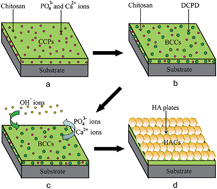Hydroxyapatite coatings with oriented nanoplate arrays: synthesis, formation mechanism and cytocompatibility
Abstract
Hydroxyapatite (HA) is the main inorganic constituent of natural bones and teeth with c-axis orientation and a(b)-axis orientation, respectively. Designing HA coatings (HACs) with specific orientation and morphology is an important strategy to improve their biological properties. Herein, we report, for the first time, the hydrothermal synthesis of HACs with oriented nanoplate arrays according to the following steps: (i) deposition of brushite/chitosan coatings (BCCs) on Ti6Al4V substrates; and (ii) transformation of HACs with oriented nanoplate arrays from BCCs after hydrothermal treatment with alkaline solutions. After soaking the BCCs in a NaOH solution under hydrothermal conditions, the Ca2+ and PO43− ions are released from the coatings because of the dissolution reaction of brushite, and they react with OH− ions to form HA nanoplates. Interestingly, these HA nanoplates with a preferential c-plane orientation are perpendicular to the coating surfaces. Hydrothermal reaction time and Ca/P ratio of BCCs have great effects on the morphologies of HA nanoplates. On increasing the reaction time from 3 h to 3 days or decreasing the Ca/P ratio from 2.0 to 1.0, the widths (or lengths) of HA nanoplates increase gradually. Simulated body fluid immersion (SBF) tests reveal that the HACs with oriented nanoplate arrays can promote the formation of apatite on the surfaces, suggesting their good in vitro bioactivity. Moreover, human bone marrow stromal cells (hBMSCs) have been used as cell models to investigate cytocompatibility of the HACs. The hBMSCs on the HACs have better cell adhesion, spreading, proliferation and osteogenic differentiation than those on Ti6Al4V substrates because the HACs are similar to the minerals of human hard tissues in chemical composition, morphology and crystallographic orientation. Therefore, HACs with oriented nanoplate arrays have great potential for use as implants of human hard tissues.


 Please wait while we load your content...
Please wait while we load your content...